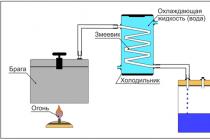Lesson on the topic
“Orthodox architecture of the Belgorod region.
Temples of the Belgorod Region - history and modernity "
Goals:
- help students become familiar with the spiritual heritage
native land;
- to foster a sense of patriotism and spiritual
moral culture of schoolchildren;
Hardware: Computer disk "Welcome to
Belgorod region.
Course of the lesson
A rough plan.
Temples of Belgorod region - history and modernity.
Spaso - Preobrazhensky Cathedral - the main temple of the Belgorod - Stary Oskol diocese
Smolensk Cathedral is one of the oldest churches in Belgorod
Nikolo - Joasaph Cathedral
Dormition-Nikolaevsky monastery.
Holy Trinity male monastery in with. Withers.
Temple of St. George the Victorious.
Savior - Transfiguration Cathedral (Gubkin)
- At the beginning of the XX century in the city of Belgorod, at that time the district town of the Kursk province, there were about fifteen Orthodox churches... Many of them were destroyed in the first half of the 20th century (for example, the Tikhvin (St. George) Church on Cathedral Square, built in 1761, the Assumption (Mikhailovskaya) Church at the corner of Civil Avenue and Belgorodsky Regiment Street, built in 1817, and others).
- Transfiguration Cathedral the second largest after the Temple of the Savior. The cathedral is located in a new residential area 1.5 km. From the center of Gubkin. Laid down on October 18, 1992 and consecrated by the Most Holy Patriarch of Moscow and All Russia Alexy on September 29, 1996.
Municipal educational institution
"Secondary school with. Olshanka
Chernyansky district of the Belgorod region "
Lesson on the topic
"Chernyansky district during the occupation"
(Olshanka village)
Task topic: Chernyansky district during the occupation. (Olshanka village)
Target: - to acquaint students with the history of their native land, its military and labor merits; - to cultivate a sense of pride in the glorious deeds of our ancestors.(Leading task. Two weeks before studying this topic, the children were given a creative task, to write a mini - essay on the topic: "My family during the Great Patriotic War")
Course of the lesson
In the spring and summer of 1942, in the front-line areas of our region, people lived in great anxiety for their fate and the fate of the country. Anxiety penetrated even more deeply into the minds of people when the Kharkov operation of the Red Army began on May 12, 1942. The operation collapsed, the troops were defeated, 134 thousand Soviet officers and soldiers were killed and taken prisoner, but then it was reported that 74 thousand were missing. This allowed the Germans to break through the defenses of our troops, the German corps launched an offensive. On June 28, 1942, east of the course, the 4th German Panzer Army, having broken through the defenses of the 40th Army, rushed to Kostorny, and on June 30, the German 6th Army broke through the defenses south of Belgorod with the task of encircling our troops in Stary Oskol. As a result of the rapid advance of tank forces, the Germans surrounded 10 divisions of the 21st and 40th armies. The left wing of the 6th Army of the German Army moved to Chernyanka and new Oskol. On July 1, the Germans occupied Korocha, and on July 2, in the middle of the day, they invaded our area, capturing the village. Vodyanoe, Krasnaya Zvezda and Krasnaya Polyana. The left flank of the 6th Army was advancing on the village. Firemen, Savenkovo, Petropavlovka, Zakharovo and Chernyanka. The first tanks with infantry on board appeared in the village of Petropavlovka at 2 pm. On this day, in the evening, the Germans occupied the red island and reached the Oskol River. For two weeks, day and night, German troops marched in a continuous stream: tanks, vehicles with infantry, artillery, carts. The power of the German army influenced the minds of some people, and they believed that the end of Soviet power had come. The Red Army was defeated, and they took the path of cooperation with the occupying power. The category of these people appeared in the villages immediately with the arrival of the Germans. Some were surrounded, others deserted from the military units that passed close to their home during the retreat. In the village of Olshanka, the Germans created a commandant's office, a little later, when a detachment of Hungarian troops arrived, a Hungarian commandant's office was created, which had nothing to do with the occupational administrative power. The primary task of the German command was to create an administrative authority. It was decided to organize a volost council on the basis of four village councils in the center of Olshanka, which included all villages along the Olshanka river, from the village of Zakharovo to the Sukhaya Olshanka farm. At the head of the volost, the German commandant put Prostakov Vasily Nikitich, the former secretary of the Olshansk village council. At the volost council, a police station was created, at the head of which was Pavel Trofimovich Sukhomlinov, a former lieutenant of the Red Army. The volost and the police station were located at the post office, the commandant's office in the MTS office, the hospital was turned into a barracks for Hungarian soldiers, the school, where the kindergarten is now, into a barracks for a labor battalion of Hungarian Jews. The shoemaker's artel housed a tank repair workshop. For complete control over the population, the parish was divided into directories. The former collective farm was headed by a director. The village was still divided into ten-courtyards headed by the foreman. This whole system was set in motion when it was necessary to fulfill the demand of the German commandant. Every day, the required number of workers was exhibited to clean and repair the premises where the occupiers lived, in winter they drove the population to clear the roads from snow. The road from Chernyanka to Stary Oskol passed through Olshanka, along which cars went day and night. The occupational administrative system worked smoothly and smoothly. Its main link was the police station. Policemen monitored the observance of the curfew, in the evening they dispersed the youth, fired rifles, beat them with rifle butts, monitored the safety of grain in the barns, took away the cattle assigned for delivery to the invaders. The youth were sent by force to Germany. People who collaborated with the Germans believed in Germany's victory over the Soviet Union and in their impunity for anti-popular and treacherous activities against their people. They continued to loyally serve the occupiers until the last days. And everyone sensed retribution when the guns of the Red Army thundered in the east. Many fled with the Germans. The hour of liberation has come for our region as well. On the morning of January 29, 1943, Chernyanka was liberated, and by evening the troops entered Olshanka without a fight. The population happily greeted their native warriors, who strove to the west, liberating village after village (Speech of the circle)Homework: compose a quiz of 15 questions "My land during the Great Patriotic War"
The city of Belgorod is rightfully considered one of the centers of Orthodoxy in Russia. Today in this beautiful Russian city there are several dozen Orthodox churches and monasteries. These are preserved ancient stone temples, and not so long ago erected modern churches. All of them create the unique look of Belgorod and are its spiritual and cultural centers.
Belgorod Transfiguration Cathedral
So, the largest temple in Belgorod is the Transfiguration Cathedral. It was erected by the architect E.L. Vasiliev on the site of a dilapidated wooden church, in 1813, at the expense of parishioners.
The Transfiguration Cathedral is a two-story stone building with a bell tower in the spirit of provincial Russian classicism. The interior lavish decoration of the cathedral is made in the spirit of "new Russian splendor".
In the late 1920s, when the Trinity Cathedral was closed, the Transfiguration Church received the status of a cathedral, but in 1962 it was also closed.
Only in July 1991 was the cathedral fully returned to the believers, and in September of the same year the relics of St. Joasaph were solemnly transferred here.
Smolensk Cathedral of Belgorod

Belgorod Smolensk Cathedral, located on Grazhdansky Prospekt, is one of the oldest temple structures. The first Smolensk church, then wooden, was built on this site in 1705, and twenty-two years later, in 1727, in its place was laid stone church... It was a two-storey building with the altar of the icon of the Most Holy Theotokos of Smolensk arranged in the lower floor, called "Hodegetria", which means "Guide", and in the upper - with the altar of the supreme holy apostles Peter and Paul.
True, over time, already in the 19th century, the Smolensk Church underwent quite significant changes. If initially the techniques of Russian architecture of the late 17th century were used in the decoration of its facades, then later they were replaced by the classical techniques of the mid-19th century.

After the revolution, the church was plundered, and during the war years it was significantly destroyed. In the 50s and 70s, even attempts were made to finally destroy it.
But already in the late 1980s, the situation in the country changed and the church began to be restored. In 1992, it was transferred to the diocese, in 1994 its lower church was consecrated, and in 1996 - the upper church.
Today there is a Sunday school here, courses for psalmists are open.
Belgorod Assumption-Nicholas Cathedral

Another ancient cathedral in Belgorod, the Assumption-Nikolaevsky Cathedral, has an interesting history, because it owes its appearance to Tsar Peter I himself, who donated one hundred rubles for its construction. It happened in June 1701, and a note about this significant event was kept in the altar of the cathedral for 200 years.
It was built within literally several years and became one of the most beautiful and richest temples in Belgorod. This was the case until 1930, when the crosses were thrown from its golden domes, the unique bell tower was destroyed, and the building of the cathedral itself was turned into a prison, where the clergy and believers became prisoners. After the war, a bakery was equipped here, and only half a century later, the Assumption-Nicholas Cathedral was recognized as a monument of history, culture and architecture and taken under state protection.

In the early 90s of the last century, the construction of the Martha-Mariinsky women's monastery began around the Assumption-Nicholas Cathedral, to which it was transferred.
Holy Cross Church of Belgorod

The main shrine of the Belgorod Holy Cross Church is the miraculous Cross, dating from the first half of the 18th century. The shrine was sent by a novice of the Athos monastery to the landowner Y. Vyrodov, his brother. Today this Large Wooden Cross is in a wooden icon case to the left of the iconostasis. It has a well-preserved ancient painting depicting the crucifixion of Christ.
The church itself was built in 1863 at the expense of the merchants Nikolai and Yegor Mukhanovs and Countess A.V. Lastovskaya. Today it is recognized as an architectural monument.
St. Michael's Church

An important architectural monument is the current Mikhailovskaya Church, built in 1844 with donations from parishioners and funds of the Belgorod merchant M.K. Machurin in the suburban Belgorod settlement Pushkarnaya.

This is a stone two-altar church, in which the main altar is consecrated in honor of the Archangel Michael, and the ancillary altar - in honor of the Monk Martyr Princess Elizabeth. Of particular interest is its four-tiered iconostasis, made in the middle of the 19th century in the Baroque style.
Joasaph Cathedral

The ancient iconostasis dating back to the 19th century has also survived in the Joasaph Cathedral, located at the New City Cemetery.
This is one of the ancient Belgorod cathedrals, built in 1799 at the expense of parishioners.
Temple of the Archangel Gabriel

Among the modern Belgorod churches, it is worth noting the temple of the Archangel Gabriel, built on the initiative of the governor and consecrated in 2001. It is located on the territory of Belgorod State University, or rather, its campus. Today, the church carries out important missionary activities, holding numerous conferences, seminars and lectures with students and teachers of Belgorod universities.
A. Krupenkov.
(According to I. Kulegaev)
A cenobitic monastery
(Holy Trinity Monastery)
Sobornaya street
(Not preserved. It was located in the quarter: V. I. Lenin Avenue (now St. Troitsky Boulevard - Frunze St. (now Glory Avenue), Bogdan Khmelnitsky St. - Chernyshevsky St. (now St. 50th Anniversary of the Belgorod Region).
a) The main throne in the main church (in the courtyard) in the name of St. Trinity, from the south. sides in the name of the Mother of God and the third - over the tomb of St. Joasaph - in the name of Of the Last Judgment... The construction of this temple began in 1690. It was consecrated in 1707. The imperishable relics of St. Joasaph. In the same church, the miraculous icon of St. Nikolai Ratny, transferred in 1765 from the abolished Root Hermitage (the village of Ustinka Belg. U., 30 versts from Belgorod, where the procession of the cross takes place annually on May 5, returning to Belgorod on May 10-11). In the monastery fence in the east there is a bishop's house (part of the upper floor is wooden), built by Bishop Vladimir; the other part of the house remained untouched, along with the stairs on the second floor.
This main church of the monastery at the beginning of the history of Byelorussia was in the cathedral fortress. In 1751. After the dilapidated parts were corrected (almost the entire roof was rotten), Bishop was consecrated again. Joasaph Gorlenko. Re-consecrated after the restructuring of the upper ranks of Bishop. Haggai in 1782 Bp. Sergius was renewed and consecrated again in 1864. Finally, the last renovation (in its present form) was carried out in 1897-98 under the Reverend Juvenalia and Laurentia; the latter in 1899 and consecrated the renovated temple. By the way, within the walls of this temple there are passages with stairs leading underground; it is believed that from here it was possible to get to the river during the siege. Lucky fetch water.
The date 1860 refers only to the present stone building; from other documents it is known that before that time there was a wooden cathedral serf church, which was dilapidated, destroyed and rebuilt several times, about a hundred years ago. It can be positively said that this Trinity Church, like a fortress church, was built simultaneously with the foundation of the city in 1593. When the Diocese was established in B., this temple in 1667 was raised to the level of a cathedral; this appointment was indicated to him by Tsar Alexei Mikhailovich, who donated him a silver-gilded cross with an inscription that has survived to this day. For the premises of the metropolitan and his clergy, the former voivodship house (part of the current bishop's house) was set aside. The chapel in the name of the Last Judgment was built in 1755 by the brother of St. Joasaph, Colonel Andrei Andreevich.

b). To the southeast of the cathedral church stands (facing sideways on Cathedral Street) a stone-vaulted church in the name of the Sign of the Most Holy Theotokos (a kind of abbreviated Znamensky Cathedral in Kursk). It was built by the efforts of Archimandrite Elpidifor as warm and consecrated to her. Iliodorus in 1835. It has two thrones: the main one in the name of the Sign, and the southern side-altar, transferred from the choirs available in the western part, in the name of St. Nicholas.
v). The home bishop's church was built in honor of Sts. Anthony and Theodosius in 1706-8; then it was abolished and renewed again. In its present form with a throne already in honor of St. Tikhon Zadonsky, it has existed since 1864 (built from cells by Bishop Sergius).
The monastery bell tower has the best old bells; a large 1100 p [oud] donated by the merchant N. Chumichev.

Kelliot nunnery for women.
(Belgorod Christmas-Bogoroditsky Convent)
(Not preserved. It was located on the site of the current regional drama theater named after M. Shchepkin)
There are about 800 monastics who are engaged in decorating icons, preparing artificial flowers, Easter eggs, embroidery, etc.
There are two churches in the city. The monastery was founded in 1622 by Apollinaria Prytkova. At first, the monastics were in poverty; so in 1673 the abbess asked Tsar Alexei Mikhailovich for salt and she was granted 5 poods. In 1717, Metropolitan Hilarion of Belgorod donated a forest dacha to the monastery (now it exists under the name "Loga", 7 versts from B. to the north), the townspeople (Count Chernyshev, merchants) began to help - and the monastery recovered. In it were the Vetka schismatics (in 1766) ?, since 1803 the Georgian queen Maria with her daughter Tamara.
The currently existing churches of the monastery:
a) inside the fence (round) - built by the townspeople in 1820 in honor of the Nativity of the Mother of God, with the southern side-chapels - in honor of the great martyrs. Catherine and the north - in honor of St. Alexey;
b) on s.-v. the corner of the fence is a warm church in the name of the Conception of St. Anna; built in 1838 by means of the merchant Nikolai Chumichev; side-altars in it: on the south side - in the name of the Korsun Mother of God, and from the north. - in the name of the great martyr Catherine.
In the "Logu" of the monastery there are two churches (there are about 10 cells with more than 50 monastics): cold in the name of the Korsun Mother of God, built in 1832, and warm in the name of the Image of the Savior not made by hands, built in 18G6 at the expense of the monastery and benefactors.
In "Log" every year, several times during the summer, religious processions are performed from the monastery with the revealed icon of the Korsun Mother of God (in the cold church "Log" there is a well on which this icon appeared). These passages are especially solemn on August 16 and October 9, when almost the entire nunnery is walking.
Nice bells and artistic ringing of nuns.

Smolensk Cathedral Church(two-story)
Smolenskaya street
(Restored in 1992. Frunze St. (now Glory Ave.).
Built in 1737 by parishioners on the site of a burnt wooden one, which was built in 1705. In this temple there is an ancient miraculous icon of the Smolensk Mother of God, which also stood in the niche of the threshold of the Belgorod fortress (here the steppes of Belgorod ended). A hundred steps from the church, on the boulevard, there is a stone chapel, created in 1903 by the Machurin merchants on the site of an ancient wooden one with a well, where from time to time they transfer miraculous icon for the performance of prayers. In the Smolensk Cathedral, the thrones:
a) on the top floor - in honor of St. Peter and Paul and
b) in the lower one - in honor of the Smolensk Mother of God and the Archangel Michael.

Assumption-Nicholas Cathedral Church
Batalionnaya Street
(st.Pushkin, 19)
Built with the diligence of the parishioners and the assistance of Peter I, who donated 100 rubles. (There is a board on the pediment). There is a legend that the soldiers of the Belgorod garrison built it. In the cold (summer) part of it there is an ancient, extremely skillfully carved iconostasis; the bell tower is noticeably inclined to the eye with loopholes. Thrones:
a) the main one - in honor of the Assumption of B [ozhiya] M [ateri],
b) in the name of St. Nicholas (warm) and St. John the Baptist. The parishioners are residents of the former suburb of Zhiloy.

Tikhvin (St. George) Church
Cathedral Square
(Not preserved. It was located on the site of the current hotel "Belgorod")
Built in 1761 by the diligence of the Belgorod governor GI Shakhovsky. Obligatory parishioners were at first the officials of the provincial administration (according to the renaming of B. in the district town). There are three thrones:
a) the main one - in the name of Tikhvin B. M,.,
b) in the name of the vlkmch. [great martyr] George and
c) in the name of ap. Philip.
In 1911, a new fence was erected by the merchant Frolov.

Transfiguration Church (two-story)
Staro-Moskovskaya street
(st.Tankista Popova, 11)
The second floor - a choir with two thrones in honor of the wives of the Myrrhbearers and the Epiphany - was built in 1813 in the Byzantine style; Sofia in Constantinople. Below are three thrones:
a) the main one - in honor of the Transfiguration of the Lord,
b) in honor of B.M.'s Sign and
c) in the name of the prophet Elijah.

Church of the Intercession. Modern look.
Photo from the site http://russian-church.ru/
Church of the Intercession.
Batalionnaya Street
(st.Pushkin, 19)
Built at the expense of parishioners in 1791. The main throne in the name of the Intercession of St. Theotokos, southern and northern chapels in the name of St. Mitrofaniya and Tikhon Zadonsky.
Assumption (Mikhailovskaya) Church
Mikhailovskaya street
(Not preserved. It was located at the corner of the present Lenin Avenue and Kirov St. (now the Belgorod Regiment St.).
Built in 1817 by means of parishioners and merchant Nikolai Chumichev. Three thrones: the main one - in honor of the Assumption of St. Theotokos, southern and northern - in the name of the Archangel Michael and in the name of the vlkmch. Barbarians. In terms of external architecture, it is the most graceful church; in terms of the harmony of its contours, it resembles the Kiev temple of St. Andrew the First-Called. In recent years, the interior has been well painted with copies from the best church painting (copies from paintings by Nevedomsky, Vasnetsov, etc.). Above royal gates there is an icon of the Assumption, which solemnly descends on a wide ribbon but the time of the all-night vigil is on 15 August. There is a lake in the fence, now heavily polluted, but once with clean water (springs) and, according to legend, medicinal. The legend, not based on anything, says that on the site of the lake there was a church that sank underground in one of the raids of the Tatars. The bourgeois church is attributed to this church. N. Chumichev almshouse (on the opposite corner of Emperor Nicholas II St.)

Vladimirskaya (Sergievskaya) church
Sergievskaya street
(not preserved. It was located at the corner of the current streets of Kommunisticheskaya (now Preobrazhenskaya) and Kirov (now St. named after Belgorodsky regiment)
Built in 1792 by means of the parishioners. Consists of two parts (the front was previously warm). In the eastern half (summer), the main altar is in honor of the Vladimir Mother of God, the second in the name of Sergius of Radonezh; in the western half (in the form of a house church) in the name of the miracle of the Archangel Michael n in the name of the martyr. [martyr] Sophia and her three daughters. In the fence, planted with trees, the remains of a rampart or trench.

Nikolaevskaya cemetery church (since 1962 - St. Nicholas-Joasaph's Cathedral) Modern view. Photo from the site http://russian-church.ru/
Cemetery-Nicholas Church.
Staro-Moskovskaya street
(Tankista Popova Street. Old city cemetery)
Built in 1799 by means of the townspeople; non-profit. Two offices: in the eastern part (summer), the main throne in the name of St. Nicholas, south. and sowing. in the name of the svsmch. Kharlampia and St. John the Long-suffering, the fourth (warm) - in the name of John the Baptist.

Vvedenskaya church.
Vvedenskaya Street
(Not preserved. It was located at the corner of the current Lenin Avenue (now Grazhdansky Ave) and Vorovskogo St. (now Kn. Trubetskoy St.).
Built in 1777 by means of the parishioners. Consists of two parts: southern (former winter) and northern (former summer), connected by arches. In it, in one of the niches, there used to be a statue of the Savior in a scarlet and a crown of thorns, made rather crudely; she usually showed up on Holy Saturday. During the renovation of the church at the end of the last century, an old gospel and some liturgical supplies were found in the wall.

Paraskevo-Pyatnitskaya (Nikolaevskaya, Women's Diocesan School) church.
Nizhne-Nikolskaya street
(Not preserved. It was located on Pugacheva street, the territory of the current cannery)
Built in 1768, by means of citizens on the place where the Nikolaevsky monastery with a wooden church was created by the order of Tsar Boris Godunov in 1599. The monastery was abolished in 1843; in the same year, a district spiritual school (bursa) was opened in the buildings of the monastery, which was transferred to the premises of the seminary in 1883 (after the latter was transferred to Kursk); after that the diocesan almshouse was placed in the buildings. For some time, the buildings of the abolished monastery were leased to local artillery. In 1907, after a solid renovation, all the premises were given over to the diocesan school for women. The estate is very large, on a raised block; enclosed by an old wall of claim with towers at the corners. During excavations in the courtyard, foundations of brickwork and coins were found. There was a large archive of the abolished monastery, either rastaskan or damaged. The church has two large (behind the kliros) icons: St. Nicholas (built during the reign of Alexander I in 1803) and the Mother of God. The latter in the previous time, in the summer, was often transferred to the well of the sl. Pokrovskaya (Podbelinskaya). In the middle of the last century, in the same church, there was a large cross found on Koshary (now it is constantly there, and in the Nikolaev Church there is a copy of it with a good letter). In this church there were many old liturgical books (late and mid-18th century) and handwritten square notes (the inheritance of the monastery), old vestments and liturgical items. Thrones in the name of St. Nicholas and vlkmch. Paraskeva. Two branches - summer and winter. The latter, in the form of a house church, was attached for the students of the theological school already in the 19th century, but now services are not performed there.
Petropavlovskaya (in Savino)
Petropavlovskaya street
(Not preserved, It was located at the corner of Litvinov (now Belgorodsky pr.) And Kalinin streets)
Built in 1777 by parishioners; thrones: in honor of Peter and Paul, in honor of Kazan B.M. and in honor of the Epiphany of the Lord.
Three Saints (new, in Savino)
Troitskaya Street (Tryokhsvyatitelskaya)
(Not preserved, It was located at the corner of the current streets Oktyabrskaya and Razdolnaya)
Built in 1874 at the expense of the merchant Fyodor Morozov. There is a good painting of the students of the academy. There are three thrones: in the name of three saints (Basil the Great, Gregory the Theologian and John Chrysostom), St. Andrew the First-Called and Fyodor Tiron.

Church in the male gymnasium (Evgenievskaya)
Georgievskaya square
(78 Kommunisticheskaya st. (now Preobrazhenskaya); the right side of the building of the current faculty of the All-Union Correspondence Financial and Economic Institute (now the Socio-Theological Faculty of BelSU)
In honor of St. Eugenia.

Church at a theological school.
Sobornaya street
(Not preserved. It was located on the current Lenin Avenue (now Grazhdansky prospect) between B. Khmelnitsky and Chernyshevsky streets (now 50th anniversary of the Belgorod region).
At the theological school there was a church, abolished by bishop. Pitirim, when parallel classes of the Kursk Theological Seminary were established in Bulgaria. Its altar remained closed, and the premises were given over to classrooms.

| Into my world |
(musical and literary composition for children of senior and preparatory groups)
Software content:
Learning tasks:
To acquaint children with the holy places of the Belgorod region.
Educational tasks:
To foster patriotism, love for Russia, respect for its history and culture.
Foster the need to do good deeds.
Developmental tasks:
To develop the idea of children about the cultural, historical and spiritual unity of the Belgorod region.
Event progress:
Leading: Hello dear guests. We are glad to welcome you in our bright and cozy hall. We would like to devote our today's event to LOVE - pure, selfless love.
Great and immense is the peace of God! God created the whole world for the life and benefit of people - for each of us. God loves us so infinitely! And if we love God and live according to His laws, then many incomprehensible things in the world will become understandable and clear to us. We will love the peace of God and will live with everyone in friendship, love and joy in our native land.
The child reads a poem:
Floods with clear light
The sun is blue.
I am dear land with you,
I am glad I live.
You are light and you are beautiful
Russian land.
I love you Russia,
My motherland!
Children perform the song "My Russia".
Physical education instructor reads A. Dementyev's poem "Russia":
... Since childhood, the winds carried us along the ground.
I listened to the forest and hugged the grass.
Still not knowing what they call Russia
The blue world I live in.
Russia began at the doorstep
And my heart continues.
She was both the field and the dear
And a rainbow bent over the village,
And like a resounding river that ran in the distance,
And about which I was thinking then,
That extinguishes the glow of a fire in the sky
Her unstoppable water.
Russia was poured into my heart like dawn,
Isn't that why my love
So inseparable from the downpours,
With a spill of herbs and the smell of bread.
And it seemed to me - there is no limit to her,
And in the spring I saw in reality
Under the sails of our white apple trees
Russia was drifting off into the blue.
Years passed: I traveled around the floor - the world.
Been in the lands, both close and foreign,
Where they know about Russia from missiles,
Yes, according to the graves of my peers.
And I believed - there is no limit to her!
And whoever's country meets us, -
Russia is everywhere, whatever you do with it, -
It spreads in the hearts of people.
Leading: Homeland - how much sense there is in this word. Endless fields, floods of rivers, a couple of whitening birches, and the house in which I grew up. All this is my Motherland - the creation of God. Showing love for the Supreme Creator, man erected God's temple.
Dear guests, I propose to take a trip to the temples and cathedrals of the beautiful city of Belgorod.
Slide number 1
PREOBRAZHENSKY CATHEDRAL CATHEDRAL.
The Church of the Transfiguration of the Lord was built in 1813 at the expense of parishioners on the site of a dilapidated wooden church designed by the Kharkov architect Yevgeny Alekseevich Vasiliev. In the late 1920s, due to the closure of the Trinity Cathedral, the Transfiguration Church received the status of a cathedral. In 1962, the Transfiguration Cathedral was among the churches to be closed and was transferred to the Belgorod Regional Museum of Local Lore. On August 19, 1990, on the patronal feast day, a divine service was held near the walls of the temple. Since September 1990, there has been a phased transfer of the cathedral to the Church. By September 1991. the temple was completely vacated in connection with the Second uncovering of the relics of St. Joasaph, Bishop of Belgorod. On September 17, 1991, the relics of St. Joasaph were solemnly transferred to the Transfiguration Cathedral, with the participation of His Holiness Patriarch Alexy II of Moscow and All Russia.
The child reads the poem "Belgorod":
Everyone knows the White City:
And in the villages and in the Kremlin!
Belgorod his name is
We are lucky - we live here.
Look from above
There are flowers all over the city
Red and blue
Oh, what beautiful!
Mom and I go to the zoo
The she-bear Mashuta is there.
She's fierce and wicked
Although, so funny!
There is a town in the central park
It was built for children.
And all day long you can hear laughter
This is how Belgorod is set up.
Thanks to everyone who lives here
Who is building the White City!
For the fact that our city is blooming,
For being forever young!
Slide number 2
SMOLENSKY CATHEDRAL.
The temple was built in honor of the sign from the icon of the Smolensk Most Holy Theotokos that took place in 1703. According to legend, the sentry Methodius Ivanov on the night of October 1–2 saw how a bright light flashed from the image of the Smolensk Most Holy Theotokos, which was at the city gates, and a wax candle was lit from it. In 1703, a chapel was built on the site of this event. In 1705 a wooden church was built, and in 1727 a stone cathedral was laid. During the Great Patriotic War, the cathedral was badly damaged. After the war, in 1958 and 1974, attempts were made to blow up the cathedral. In the 80s, the building was restored into an organ hall. In 1991, the temple was returned to the believers.
The child reads the poem "Belogorie":
I drive in the forest, I drive in the field,
I'm driving along Belogorie.
I'll look at my native land:
What a miracle before me!
On the left is a white mountain
And from the nearest hillock
A trickle like a tomboy
Rushing to the Seversky Donets.
Ahead - a village in the gardens
Reflected in the ponds
And the church is small
It illuminates the souls of people.
And I thought about
It's good in the native land.
Slide number 3
TEMPLE OF THE MORTARS OF FAITH, HOPE, LOVE AND THEIR MOTHER SOPHIA.
The foundation stone was consecrated in May 1997. Excavation work began in 2005. For a long time, the project of the temple was approved, so the main construction began in 2008. On May 15, 2009, a fire broke out and the temple was almost completely burned down. At the time of the fire, it was under construction. 17 domes that have already been installed were brought from Volgodonsk. In almost a year, the temple was rebuilt after a fire and completed. On May 2, 2010, His Holiness Patriarch Kirill of Moscow and All Russia performed the great consecration of the church in the name of the holy martyrs Vera, Nadezhda, Lyubov and their mother Sophia on the Kharkov mountain of Belgorod and the Divine Liturgy in the newly consecrated church.
Slide number 4
CHURCH GEORGE THE VICTORITY
In the southern microdistrict of Belgorod there is an amazing Temple of the Great Martyr George the Victorious. On May 25, 1997, the stone was laid for its construction. In 2001, its construction was completed by the architect L.I. Kolesnikova. It is made in the traditions of ancient Russian building art, the temple is wooden. Its structure stretches from west to east and consists of gilded domes, a "four", a tent-type bell tower. With the blessing of Archbishop John of Belgorod and Starooskolsk, on Korolev Street, the construction of a Spiritual and Educational Center began in the temple complex in the name of the Holy Martyrs Faith, Nadezhda, Lyubov and their mother Sophia. Near the Temple there are chapels of the Life-Giving Trinity and in honor of the Monk Seraphim of Sarov. The Chapel of the Life-Giving Trinity was consecrated in 1999, when the Temple began to be built. Believers from the nearest micro-district of Kharkovskaya Gora came to her service. The chapel of St. Seraphim of Sarov was consecrated by Archbishop John of Belgorod and Stary Oskol on August 4, 2003.
Dance "Belgorod - my beloved city".
Slide number 5
KRESTOVOZDVIZHENSKY TEMPLE.
It was built at the expense of Countess A.V. Lastovskaya and the merchant brothers Nikolai and Yegor Mukhanovs in 1863. The main shrine of the temple is the miraculous Cross, sent to the landowner Yuri Vyrodov by his brother, a novice of the Athos monastery. (Dated to the first half of the 18th century). But the landowner did not have reverence for the shrine, and once, after an unsuccessful hunt, he ordered to throw the Cross into the swamp. The miraculous finding of the desecrated shrine took place at the end of the 18th century. The blind man who heard the promise in a dream that he would be healed if he found and carried the Cross out of the bog, immediately received his sight, having touched his find. Many cases of healings from various ailments have been witnessed in front of the Koshar shrine. In Soviet times, the temple was closed for a very short time. He was not subject to ruin. Several ancient icons have been preserved in it. For example, the icon of the Mother of God "Quick to Hearken", the image of the Archangel Michael. In 1997, a Sunday school for children and catechism courses for adults were opened at the church. The temple is an architectural monument of the eclectic era. The decoration of the temple is dominated by architectural elements from Russian architecture.
Dance with handkerchiefs.
Leading: Dear guests, at the end of our event, we would like to wish you pure and sincere love. Love and be loved!
The child reads the poem "About Good":
In desperation, we often notice
That there is no strength to break the ring of troubles,
And in every person we meet
The face of the enemy is an unkind face.
We do not often remember the commandments of God:
That we must love our neighbor,
We consider everything a lie, treachery, a lie,
And you can't turn back evil thoughts!
You can't live by the laws of a wolf pack.
Remember how you crucified Christ!
Let us be more merciful, people will become.
After all, life is already very difficult.
Let us pity the mourners,
Let's cry together over someone else's misfortune.
And we will take part in the life of our neighbor,
And let's give our hearts water!
I. N. Golovacheva, musical director
NDOU "Orthodox kindergarten
"Rozhdestvensky", Belgorod














